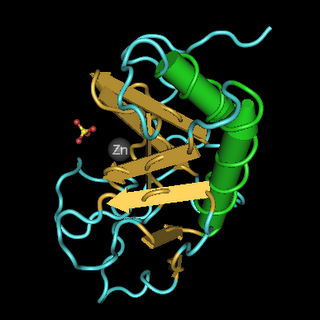Sonic Hedgehog
There's an interesting article on Sonic Hedgehog in the January 18 issue of Nature. I'm used to seeing this gene mentioned when discussing mammalian function or development but not fish--although the article refers to cartilaginous fish only. While both humans and cartilaginous fish are vertebrates we diverged so long ago from the chondricthylans that it's easy to forget that we still share quite a few genes.
 One of those genes is Shh, commonly referred to as Sonic Hedgehog, pictured over there to the left. Shh, in mammals, encodes a signaling molecule that plays a central role in developmental patterning, especially of the nervous system and the skeletal system. It's highly conserved and mutations in the gene result in serious maladies such as holoprosencephaly type 3. I'm familiar with Sonic Hedgehog due to its being implicated in causing tumors and thus of interest to cancer investigators.
One of those genes is Shh, commonly referred to as Sonic Hedgehog, pictured over there to the left. Shh, in mammals, encodes a signaling molecule that plays a central role in developmental patterning, especially of the nervous system and the skeletal system. It's highly conserved and mutations in the gene result in serious maladies such as holoprosencephaly type 3. I'm familiar with Sonic Hedgehog due to its being implicated in causing tumors and thus of interest to cancer investigators.
Getting back to the article in Nature, it demonstrates how Shh is conserved functionally between chondrichthylans and tetrapods / ray finned fish.
From that one can infer how Shh conservation across distantly related species illustrates evolutionary trends regarding vertebrates in general. The Wikipedia article I linked to above states in one section that the absence (non-expression) of Shh has been shown to control the growth of nascent hind limbs in cetaceans (whales and dolphins) but this article demonstrates that conservation of the gene is strong across a much wider span. The Methods section of the paper is quite interesting to someone like me, who's never done any work with ocean based organisms. In a way, the methodology reminds me of doing angiogenesis experiments using eye-based capillary growth. Of course when we do that we don't have to do it under seawater.
In case you're wondering why any of that might interest you, this relates to the evolutionary question of how land based animals developed limbs from the morphologically similar fins found on fish. It's easy to see the homology between a human arm, a whales flipper, and the fin of a fish but tracing the change in gene expression is a deeper game since we don't have genetic samples of the transition critters. They're long dead and gone. So we examine gene expression in living animals and work from there.
 One of those genes is Shh, commonly referred to as Sonic Hedgehog, pictured over there to the left. Shh, in mammals, encodes a signaling molecule that plays a central role in developmental patterning, especially of the nervous system and the skeletal system. It's highly conserved and mutations in the gene result in serious maladies such as holoprosencephaly type 3. I'm familiar with Sonic Hedgehog due to its being implicated in causing tumors and thus of interest to cancer investigators.
One of those genes is Shh, commonly referred to as Sonic Hedgehog, pictured over there to the left. Shh, in mammals, encodes a signaling molecule that plays a central role in developmental patterning, especially of the nervous system and the skeletal system. It's highly conserved and mutations in the gene result in serious maladies such as holoprosencephaly type 3. I'm familiar with Sonic Hedgehog due to its being implicated in causing tumors and thus of interest to cancer investigators.Getting back to the article in Nature, it demonstrates how Shh is conserved functionally between chondrichthylans and tetrapods / ray finned fish.
From that one can infer how Shh conservation across distantly related species illustrates evolutionary trends regarding vertebrates in general. The Wikipedia article I linked to above states in one section that the absence (non-expression) of Shh has been shown to control the growth of nascent hind limbs in cetaceans (whales and dolphins) but this article demonstrates that conservation of the gene is strong across a much wider span. The Methods section of the paper is quite interesting to someone like me, who's never done any work with ocean based organisms. In a way, the methodology reminds me of doing angiogenesis experiments using eye-based capillary growth. Of course when we do that we don't have to do it under seawater.
In case you're wondering why any of that might interest you, this relates to the evolutionary question of how land based animals developed limbs from the morphologically similar fins found on fish. It's easy to see the homology between a human arm, a whales flipper, and the fin of a fish but tracing the change in gene expression is a deeper game since we don't have genetic samples of the transition critters. They're long dead and gone. So we examine gene expression in living animals and work from there.

Comments
This is just the sort of article that would side track me when I was a student. I would go to the library to research one thing and would find all sorts of other interesting things to read about!
Thanks for once again taking the amazingly complex and making it not only understandable, but fascinating for the rest of us.